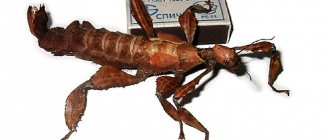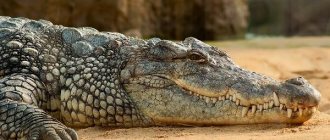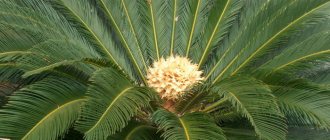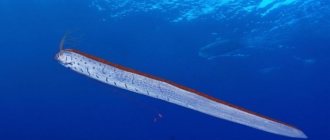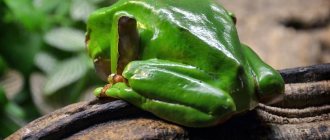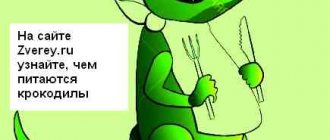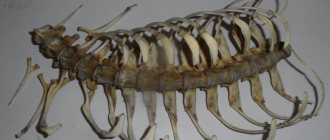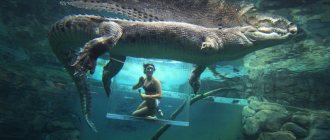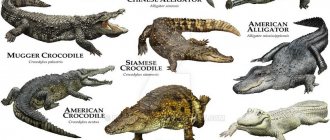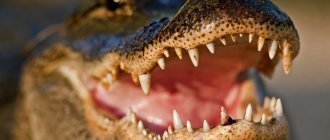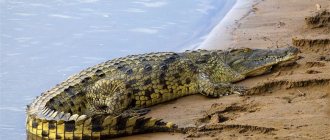Who are crocodiles
Crocodiles are huge, several meters in size, possessing incredible strength and very bloodthirsty reptiles that appeared on our earth at the same time as dinosaurs. They are direct descendants of ancient archosaurs who lived back in the Mesozoic era. This family connection is still reminiscent of the appearance of the crocodile, its lifestyle, method of obtaining food and habits.
Description of the crocodile
The body, tail and legs of the crocodile are covered with lumpy hard skin, which has turned into ossified plates, somewhat reminiscent of sea coastal pebbles, which is where its name comes from. Krokodilos, translated from Greek, literally means “pebble worm.” Although the worm is not at all ordinary, but simply incredibly huge. The sizes of crocodiles, depending on the species, range from 2 to 6 meters, and their weight reaches almost a ton. There are also larger individuals, for example, saltwater crocodiles can reach a weight of 2000 kg. Females are usually almost half the size of males.
According to the existing classification, there are real crocodiles, alligators and gharials. The general structure of all species is quite similar and is maximally adapted to living in an aquatic environment: a flattened body, a flat head with a long snout, a long tail compressed from the sides and short legs. There are 5 toes on the front paws and 4 on the hind paws, connected by membranes. Eyes with vertical pupils, nostrils are located on the upper surface of the head, which allows the crocodile, completely immersed in water, to breathe freely and see everything in the area. They have very developed night vision, and their ear openings and nostrils can be covered with folds of skin.
These reptiles have an original respiratory system. They have large lungs that hold a lot of air, allowing them to hold their breath for a long time. Special muscles around the lungs can move the air in the lungs relative to the center of gravity, thereby regulating buoyancy. A diaphragm made of connective tissue can shift internal organs in the longitudinal direction, which changes the center of gravity of the body, ensuring the desired position of the body afloat and under water. In addition, the nasopharynx is separated from the oral cavity by the secondary bony palate, thanks to which the crocodile can keep its mouth open under water, while continuing to breathe with its nostrils located on the surface of the water, and the velum and a special valve do not allow water into the windpipe.
The crocodile has a unique circulatory system. The heart is four-chambered with two atria and two ventricles separated by a septum. But the special structure, if necessary, ensures in the aorta, leading to the digestive system, the replacement of arterial blood with venous blood saturated with carbon dioxide, which enhances the production of gastric juice and speeds up the digestive process. Therefore, a crocodile can swallow food in huge pieces or even whole, it will still be digested. His blood contains strong antibiotics that prevent infection even in very dirty water. In addition, hemoglobin in the blood of a crocodile carries several times more oxygen than in land animals and humans, so crocodiles are able to hold their breath and, without surfacing, remain under water for up to 2 hours.
The digestive system of crocodiles also has its own characteristics. So their teeth are constantly renewed every two years, so they are not afraid of losing a tooth, a new one will still grow. The tooth is hollow inside and a replacement grows in this cavity; as soon as the tooth wears off or breaks, there is already a ready-made one to replace it. The stomach is large and thick-walled; inside there are gastrolith stones, which the crocodile uses to grind food. The small intestine is short and passes into the large intestine with access to the cloaca. There is no bladder at all, probably due to life in water.
Crocodiles and alligators are different from each other. Externally, this is visible from the structure of the jaws. A real crocodile has a sharper muzzle, and when the mouth is closed, the fourth tooth of the lower jaw protrudes outward. The alligator has a blunt muzzle, and when the jaws are closed, the teeth are not visible. In addition, a real crocodile has special lingual salt glands on its tongue, and lacrimal glands near the eyes, which remove excess salt from the crocodile’s body. This is manifested by the so-called tears of a crocodile, due to which a real crocodile is able to live in salty sea water, and an alligator only in fresh water.
Almost all crocodiles, except for the fish-eating Ghanaian gharial, feed on animal food, or rather on everything that lives in the water and in the coastal zone. With age, their diet changes somewhat, but this is more likely due to their growth, increase in size and naturally the need for more food. Thus, young individuals hunt mainly for fish and small invertebrates and amphibians. Adults catch larger fish, water snakes, turtles, and crabs. Often their prey is monkeys, hares, kangaroos, porcupines, raccoons, martens, mongooses, in short, all animals that go to water, including domestic ones. Some of them become cannibals, that is, they eat each other. Large species, such as the Nile, combed, swamp and some others, are quite capable of dealing with prey that is larger than itself. Thus, Nile crocodiles often attack antelope, buffalo, hippopotamus, and even elephants. They eat a lot; at one time an adult crocodile is able to absorb food equal to a quarter of its weight. Sometimes part of the prey is hidden, although it rarely remains intact; usually it is taken away by other predators.
Crocodiles have unique hunting tactics. The crocodile, immersed completely in the water, leaving only its eyes and nostrils on the surface, quietly swims up to the animal drinking water, then with a swift throw it grabs the victim and pulls it into the water, where it drowns. If the victim resists strongly, then he, rotating around his axis, tears him apart. Crocodiles cannot chew food, they simply tear their prey into pieces and swallow it, swallowing small animals whole.
Another feature of crocodiles is that the cartilage in the bones of its skeleton is constantly growing and, as a result, the crocodile itself grows throughout its life, increasing in size over the years. By the size of a crocodile you can determine its age. And if you consider that some species of crocodiles live up to 70-80 years or more, it is not surprising that incredibly huge individuals of these reptiles can be found. In addition, crocodiles do not shed throughout their lives; their scaly skin grows with them and over the years it ossifies and becomes incredibly durable. Hardened rectangular plates on the skin, arranged in regular rows, eventually turn into a real impenetrable shell. It is because of this durable skin that crocodiles have become the subject of hunting by people, who have been using it for their needs for a long time. From time immemorial, people have made shoes, bags, belts, suitcases and other durable items from crocodile skin. Therefore, many species of crocodiles that lived on earth a couple of hundred years ago completely disappeared. There are now 23 species of these reptiles around the world.
The skin color of crocodiles depends on their habitat. Usually it is a protective dirty brown, gray, and sometimes almost black color. Quite rarely, albinos are completely white. Such individuals usually do not survive in the wild.
Like all cold-blooded animals, crocodiles' body temperature depends on the external temperature and therefore they live only in regions with a tropical climate. Crocodiles are common in Africa, Australia and Oceania, the countries of Indochina, North and South America. Most species of crocodiles prefer fresh water, but crocodiles such as combed and sharp-snouted crocodiles are also adapted to salt water. For most species of crocodiles, the most favorable temperature is between 32-35 °C. Temperatures below 20 and above 38°C are extremely uncomfortable for them. You can often see a crocodile opening its mouth wide for a long time. This is done so that water evaporates from the mouth, cooling the body. At such moments, small birds sit in his mouth and peck off stuck pieces of food, thus cleaning his teeth. Crocodiles do not touch such birds and in the end both benefit.
For thermoregulation, these reptiles have special osteoderms under the horny plates of the shell that can accumulate solar heat, due to which the fluctuation in their body temperature during the day usually does not exceed 1-2 degrees. However, with the onset of cold weather or drought, many hibernate. They dig holes in the silt at the bottom of drying up reservoirs, similar to cracks, and lie in them, often several individuals together, until a comfortable temperature occurs. Although it was recently discovered that some species of crocodiles, by tensing their body muscles, can warm up the blood themselves, thereby raising body temperature by 5-7 degrees above the ambient temperature.
Hunting and food
Despite the fact that crocodiles prefer to hunt at night, during the day, if the prey is not far from them, they do not leave it without attention. They receive information about a potential victim thanks to receptors located on their jaws, which are able to sense prey located even at a great distance.
They feed mainly on fish, but if they come across other prey that they can handle, they hunt that too. How dangerous they are to humans depends on the species. For example, the Nile crocodile is a cannibal, but the gharial (also large) is absolutely not dangerous.
The food preferences of a crocodile largely depend on its age and size: young individuals prefer invertebrate animals, adults prefer amphibians, small mammals, reptiles, and birds.
But large individuals (the same Nile crocodile) are able to cope even with victims that are significantly larger than them in size: the Nile crocodile catches wildebeest when they cross rivers during migration, the combed predator opens a hunt for cattle during the rainy season, the Madagascan one succeeds catch a lemur, and in search of water he crawls into caves (during drought it can only be found here). If necessary, these animals are capable of eating their own relatives.
These reptiles cannot chew, and therefore, having caught the victim, they dismember it with their teeth and swallow it in parts. If the food is too large for this, they can leave it at the bottom for a while and wait until it gets soggy. The animal is helped to cope with food by swallowing stones, which grind the food. These stones are often quite large in size: it is known for sure that the Nile crocodile is capable of swallowing a five-kilogram block.
Crocodiles eat carrion very rarely, and they cannot tolerate rotten food at all. Reptiles eat a lot: at a time they are able to swallow food weighing about 25% of their body weight. Since 60% of food is stored in fat, if necessary, they are able to fast for one to one and a half years.
Lifestyle of crocodiles
The way of life of crocodiles is unique. They spend most of their time in the water. They come ashore in pursuit of prey or to bask in the sun. The main propulsion device in water for a crocodile is its tail. Acting with its tail like a huge oar, a crocodile can reach speeds of up to 30-35 km/h in the water. The tail also acts as a rudder, so both afloat and underwater the crocodile can abruptly change the direction of movement. On land, these reptiles are slow and rather clumsy, but when attacked they make very fast attacks. In the normal position, the crocodile’s legs are spread wide apart, but when running, it carries them under the body and can, changing to a gallop, cover short distances at speeds of up to 18 km/h.
According to scientists, the ancestors of crocodiles mainly lived on land and only went into the water when necessary. Therefore, they retained the ability to reproduce on land. Spending most of their lives in water, they lay eggs on land. Their ability to reproduce appears at 8-10 years of age. At this time, their length reaches about 2.5 meters in males, and up to 1.7 meters in females. The breeding season for southern species is in winter; northern crocodiles lay eggs in autumn.
Crocodiles communicate with each other in a voice similar to either a dog barking or a roar. With the onset of the mating season, the habitats of crocodiles are filled with their heart-rending roars, which means scaring away rivals and calling for females. Usually, during breeding, males show wild aggression among themselves, organizing fights to the death. To attract females, males, in addition to screams, create noise by splashing their muzzles on the water. Having dealt with their rivals, the couple retires and spends time together. The female builds a nest in the shallows near the water. To do this, she digs a hole up to half a meter deep, covers it with leaves, branches, dirt or sand and lays from two to eight dozen eggs. When the clutch is ready, the female covers the nest with the same materials. In places with lush vegetation, nests are made entirely of branches and leaves, covering them with mud to retain heat.
Both parents take care of the safety of the clutch, staying nearby and protecting their future offspring from the encroachment of uninvited guests. And still, no more than 20% of the eggs are preserved in the clutch, because crocodiles’ nests are destroyed by other predators or people while the parents are away.
After three months, small crocodiles hatch from the eggs. At the same time, they squeak quite loudly, attracting the attention of the mother who, hearing these sounds, digs up the nest. If one of the crocodiles is unable to break the egg shell, the female helps them by carefully crushing the eggs with her tongue and palate, helping the cubs get out. These reptiles have another property inaccessible to other animals, which is that the sex of the future crocodile can be determined by the method of thermoregulation. If incubation takes place at a temperature of 32-33°C, approximately the same number of males and females are born. If the temperature is higher, there will be more males; if it is lower, there will be more females.
The cubs are quite small, the largest of the Nile crocodile are about 30 cm long. The babies themselves cannot get from the nest to the water, and therefore the mother takes several of them into her mouth and carries them to the water, where they can immediately swim. At first they grow very quickly. They feed on everything they can grab: mollusks, worms, bugs, blades of grass, fish fry and frog tadpoles. The crocodile takes care of her cubs for up to two years. During this time, there are very few of them left, but those that survive grow up to one meter in length and can already get by on their own.
Crocodiles are dangerous to humans to varying degrees. Some, such as the gharial, never attack people, others, like the saltwater and Nile crocodiles, will never refuse to attack if the opportunity presents itself. Well, such as the black caiman or the sharp-snouted crocodile attack quite rarely, mainly if they are provoked by the person himself or they are very hungry.
For many tribes in Africa, Indochina and Australia, crocodiles have been revered animals from time immemorial. And in the ancient cultures of these peoples, the crocodile was even considered a sacred animal. The ancient Egyptians considered the god Sebek, who was depicted as a man with a crocodile head, to be the patron of fishermen, who controlled the floods of the Nile, the main river of Egypt. Sebek, as the personification of strength and dexterity, was especially revered by hunters. Even the pharaohs turned to Sebek for blessings for good luck before battles with enemies. They believed that Sebek was a messenger of the god Ra, who arose from a stone.
Pharaoh Amenemhet III, on the site of present-day Kiman Faris, built the entire city of Shedit, which the ancient Greeks called Crocodilopolis, in which a temple was erected in honor of the crocodile god Sebek, and a huge labyrinth of 3000 rooms in which, according to Herodotus’ description, the priests kept a sacred crocodile decorated gold and diamonds as the earthly incarnation of Sebek.
How long this lasted is not known, but judging by the fact that after death, these sacred crocodiles, like priests and pharaohs, were mummified, and in Kom el-Breighat alone there is a cemetery where almost two thousand crocodile mummies were discovered; they were deified for more than one thousand years. Moreover, nearby are the remains of the pyramid of Amenemhat III himself.
Currently, in the natural environment, only a few live to a respectable age, and not because they develop some kind of disease, but because they are caught, killed and transferred to skin and meat. In many national cuisines, crocodile meat is considered a delicacy. In addition, due to the great demand for leather, there have been farms for their breeding in many countries for several decades. Crocodiles breed well in captivity, but they are not kept there for a long time; one and a half to two meters is enough to get a significant benefit.
As we have already mentioned, about two dozen different crocodiles now live on earth. Here are the main most common types.
Reproduction
Considering that crocodiles live from 50 to 110 years, they reach sexual maturity quite early: at the age of 8 to 10 years. Crocodiles are polygamous animals: a male may well have a harem of twelve females.
The female does not give birth, but lays eggs (about fifty eggs per night). To do this, she goes to the coast and digs a hole, the size of which largely depends on the illumination: deeper in the sun, shallower in the shade, and then covers it with sand or leaves. It takes about three months for the eggs to hatch. The female spends all this time near them, without going anywhere and not even feeding.
Who exactly will hatch depends largely on the air temperature: if they exceed 32°C, a male will appear, from 28 to 30°C - a female. Before breaking the shell, one or the other small crocodile begins to make grunting sounds. This is a signal for the female, and she first digs them out, then rolls them in her mouth and releases the babies.
The crocodiles that are born are small: their length is only 28 centimeters. At a time, the mother collects about two dozen babies in her mouth and transfers them to a pre-selected small reservoir, where they spend about eight weeks, after which they scatter around the surrounding area in search of reservoirs unoccupied by other crocodiles. Because of this, the mortality rate among crocodiles is very high: many are eaten by birds, monitor lizards and other predators. Those that survive, as they grow older, first feed on insects, then begin to catch frogs and fish from reservoirs, and from the age of ten they begin hunting large vertebrates.
Species of crocodiles
The combed crocodile , in Latin Crocodylus porosus, is the largest of all existing ones. Otherwise called: sea, salty, Indo-Pacific, saltwater and even man-eating crocodile. This monster can be up to 7 meters or more in length, and weigh up to 2 tons. On its snout, from the edge of its eyes, there are 2 bony, comb-like protrusions, which is why it got its name. Typically, the saltwater crocodile is brownish in color with dark spots and stripes on the body and tail. It lives in sea lagoons and in the mouths of rivers flowing into the ocean, along the coasts of India, Indochina, Japan, Indonesia, Australia, and the Philippines. Often found in the open sea far from the coast. It feeds on any prey that it manages to catch. In the water these are fish, turtles, dolphins, sharks, stingrays and other aquatic inhabitants. On land, these are animals going to water: antelope, buffalo, wild boar, kangaroos, bears, monkeys and domestic sheep, goats, pigs, dogs, cows, horses and of course waterfowl. He will not miss the moment to attack a person who is within his reach.
The Nile crocodile , or Crocodylus niloticus in Latin, is the second largest crocodile after the saltwater crocodile. On average, these African crocodiles range in length from 4.5 to 5.5 meters and weigh about 1 ton. Their color is mostly gray or light brown, with dark stripes on the back and tail. This is the most ferocious of all species, not taking into account any other animals even significantly larger than it in size. This animal alone is not afraid to attack a buffalo, hippopotamus, rhinoceros, giraffe, lion or even an elephant, from a fight with which it almost always emerges victorious.
The marsh crocodile is Crocodylus palustris, also known as the Indian crocodile or magher. The marsh crocodile is also very large, up to 5 meters long and weighing on average about 500 kg. The color is dark green, marsh color. With its wide snout it looks like an alligator. Mager, translated from Hindi, means “water monster,” although Indian fishermen call it a robber, because these crocodiles steal fish, and when the opportunity arises, they attack the fishermen themselves. It lives in India and neighboring countries along the banks of rivers and lakes, and in swampy jungles. During times of drought, mageras burrow into the swamp mud and hibernate until the monsoon season begins. On the island of Ceylon there is a species of this crocodile called the Kimbula. The Ceylon crocodile can live in salt water and prefers lagoons along the ocean. He is very aggressive and attacks people quite often.
The American sharp-snouted crocodile (Crocodylus acutus) is the most common of all species. It received this name due to the shape of its narrow, pointed muzzle. It grows up to 5 m in length and weighs up to 1000 kg. The color is usually green-brown or gray. It lives in rivers, lakes and swamps of Central America, the southern United States and northern South America. It feeds mainly on fish, waterfowl and turtles. When there is not enough food, it attacks livestock. Attacks on humans are very rare.
African narrow-snouted crocodile - Crocodylus cataphractus is quite large in size, living in swamps and tropical rivers of Western and Central Africa. The usual length is about 2.5 meters, but up to 4 meters are also found. It received this name because of its narrow muzzle. Unlike other crocodiles, the hard plates on its neck are arranged in 3-4 rows, and on its back they merge with the scales, for which it is called an armored crocodile. It feeds on fish and small aquatic inhabitants. It builds nests from plants on the shore near the water. We lay few eggs, no more than two dozen; the incubation period is longer than that of other species, often almost 4 months. The population of African narrow-snouted crocodiles is falling due to uncontrolled hunting. It is believed that there are no more than 50,000 of them left.
The Orinoco crocodile - Crocodylus intermedius in Latin - is one of the rarest species. It is similar to the American sharp-snout both in appearance and in size, the length reaches up to 5.2 m. The color is light green and gray with dark spots. The muzzle is long, like that of an African narrow-snout. It feeds mainly on fish and small animals. During drought, when the water in the rivers decreases, it hides in holes on the river banks and hibernates. For a long time it was one of the most hunted crocodiles in South America, as a result of which almost all of them were exterminated. Now there are no more than one and a half thousand individuals left. It lives mainly in Venezuela and Colombia and on nearby islands.
Australian narrow-snouted crocodile - Crocodylus johnstoni, another name for Johnston's crocodile. It is not particularly large in size, but 3 meters in length and a weight of up to 100 kg are also impressive, especially since it reaches such dimensions around the age of 25. This crocodile has strong legs with large claws and a narrow, pointed snout, from which it gets its name. The color is mostly light brown, with dark stripes appearing on the body and tail. It feeds mainly on fish, but also does not refuse amphibians and small land animals. It lives in the west and north of Australia in rivers, lakes, and swamps with fresh water, which is why it is sometimes called the freshwater crocodile.
Philippine or Mindorek crocodile - Crocodylus mindorensis got its name from its habitat, these are the Philippine Islands and in particular the islands of Mindoro, Negros, Samar, Buzuanga, Jolo, Luzon. The crocodile is relatively small in size, no more than 3 meters in length. The muzzle is quite wide, somewhat similar to the New Guinea. The color is gray with transverse darker stripes on the body and tail. Lives in fresh water bodies: lakes, ponds, lakes, swamps. Sometimes he changes his place of residence and goes to the ocean coast. Usually active at night, during the day it lies in secluded places. It feeds on fish, small invertebrates, waterfowl and small animals that come to drink. Considered a rare species, only a few hundred remain in nature and has been listed in the Red Book since 1992.
Central American crocodile , Morelet's crocodile, in Latin Crocodylus moreletii. The name itself speaks of its habitat, widespread in the countries of Central America: Mexico, Guatemala, Belize. A relatively small species, the maximum length is about 3 meters. The color is gray, sometimes gray-brown, there are dark stripes on the body and tail, the belly is lighter. The difference from other species is that its skin has fewer keratinized plates, they are located mainly on the top of the neck, the stomach does not have such protection at all, which is why it is called a soft-bellied crocodile. The population is limited, with only a few thousand left in the wild.
The New Guinea crocodile or Crocodylus novaeguineae, a fairly rare species, is currently found only on the islands of Papua New Guinea and Indonesia. This is a medium-sized crocodile, the maximum length is about 3.5, females up to 2.7 meters. Somewhat similar to its Siamese counterpart. The muzzle is narrow, slightly elongated. The color is gray with darker stripes on the body and tail. Lives only in fresh water, prefers swampy areas. This is a typical nocturnal predator, becoming more active at dusk. Food is mainly fish, birds, small animals and crustaceans and everything that can be handled. During the day he sleeps in secluded places. The skin of this species is not in particular demand, so the population is stable at around 100,000 individuals, although it is listed in the Red Book.
Cuban crocodile - Crocodylus rhombifer, medium to small in size. The usual length is up to 2.5 meters in length and weight is about 40 kg. They are also found up to 3.5 meters in length and weighing up to 200 kg. In 1880, a specimen 5.3 meters long was captured. Under natural conditions, it lives in Cuba in the swamps of the Zapata Peninsula conservation area and on the island of Isla de la Juventud. Although it is a relatively small crocodile, it is considered the most aggressive of all species. It has great agility and enormous bite force that reaches 2 thousand kilograms. It feeds on everything it can catch and handle. It attacks people very rarely, but it constantly hunts domestic animals, because although it is a semi-aquatic animal, it spends a lot of time on land. Another feature of this crocodile is the ability to jump high out of the water. It often happens that Cuban crocodiles jump out of the water and grab small animals or birds from tree branches.
Siamese crocodile - Crocodylus siamensis, a medium-sized species. The usual length is 3 meters, maximum 4 meters. The weight of males is up to 350 kg, and females no more than 150 kg. However, they sometimes interbreed with saltwater crocodiles and then the size of these hybrids can be much larger. Siamese crocodiles are a bit like saltwater crocodiles, especially the young ones. Their color is green-olive, and there are also dark green ones. They feed on fish, shellfish, reptiles, small animals and birds. Habitat of the country of Indochina: Vietnam, Thailand, Cambodia, found in Malaysia. Siamese crocodiles are an endangered species, listed in the Red Book. Now there are no more than 5 thousand of them, taking into account the fact that in Cambodia they are bred in nurseries.
African dwarf crocodile - Osteolaemus tetraspis, another name for the blunt-nosed crocodile, the smallest of all living on earth. It is only 1.5 meters long. It lives in Central and Western Africa, in tropical swamps and rivers. It feeds on fish, frogs, small reptiles, snails and even insects or carrion. This crocodile, due to its small size, is often susceptible to attack by other predators, but, compared to other species, it has good protection from ossified plates on the sides, neck and tail. Due to the inaccessibility of the regions where this species of crocodiles is located, it has been little studied. But, as far as we know, it is constantly hunted, since its skin and meat are in great demand. Although, according to the latest information, the African dwarf is not in danger of extinction.
Mississippi alligator - lat. Alligator mississippiensis, or otherwise the American alligator, is a large species of reptile from a separate family of alligators. Reaches a size of up to 4.5 m in length and a body weight of up to 400 kg. It differs from a crocodile in that it can live only in fresh water and easily tolerates cold. It lives in rivers, lakes and ponds of North America, mainly in the southern United States. It feeds on fish, turtles, reptiles, birds and small animals that live near water or come to drink: nutria, raccoons, muskrats, etc. It rarely attacks large animals and humans. For many years, Mississippi alligators have been bred on special farms for their skin and meat. Albinos of white color are often found among this species.
The Chinese alligator - Alligator sinensis is much smaller than its American counterpart. The maximum length of these reptiles is a little over 2 meters, females up to one and a half meters. It feeds on fish, shellfish, snakes, small animals, and birds. The only place where this species lives is the Yangtze River basin in China. This is a rare species, almost completely exterminated by humans. In natural conditions there are several hundred individuals. Recently, Chinese alligators have begun to be bred on special farms for commercial purposes to obtain skins and meat. These reptiles are the calmest of all types of crocodiles; they can attack a person only for the purpose of protection.
The black caiman or Melanosuchus niger is one of the largest crocodilians. The body size of a male can reach 5.5 m and weight 500 kg. and more. Like all caimans, there are bony projections on the head behind the eyes that distinguish them from true crocodiles. Lives in lakes and rivers of South America. It feeds mainly on large animals that come to water: deer, monkeys, armadillos, otters, livestock, etc. He also does not refuse fish, including the famous piranha, which he is not afraid of, thanks to his durable shell of ossified scales. It is nocturnal, fortunately it has well-developed night vision, and the dark color is a good camouflage. Rare cases of attacks on people have been recorded.
Crocodile caiman , in Latin Caiman crocodilus or spectacled caiman, is relatively small in size. The usual body length is up to 2 m and weight is about 60 kg. He has a narrow muzzle and a specific bone growth between his eyes that resembles glasses. It lives in all bodies of water in Central America, Mexico, Brazil, Colombia, Honduras, Panama, Nicaragua, Costa Rica, Dominican Guyana, Guatemala and the Bahamas. It feeds mainly on fish, crabs and shellfish. Sometimes it attacks wild boars, other caimans and even anacondas. Although quite often they themselves become victims of larger predators: black caimans, jaguars and large anacondas. The most common type of large population.
Broad-faced caiman in Latin Caiman latirostris is medium-sized, usually just over 2 meters, olive green in color and has a wide jaw, which is how it got its name. It lives in rivers and mangrove swamps on the Atlantic coast of many countries in South America, Argentina, Brazil, Uruguay, Paraguay, and Bolivia. Often found in ponds near human habitation. It feeds mainly on fish, snails, and mollusks. Adult caimans catch turtles and capybaras.
The skin of the broad-faced caiman is in great demand, so as a result of poaching in the last century, large numbers of them were exterminated. However, due to the inaccessibility of its habitats, the population has survived; it is believed that between 250,000 and 500,000 individuals of this species now exist in nature.
Paraguayan caiman - Caiman yacare, yacar or piranha caiman. It received so many names for a reason; it is the most common species of caiman and crocodiles in general. It lives everywhere in swampy places, rivers and lakes of Brazil, Argentina, Paraguay and Bolivia. Relatively small, only 2 meters in length, the Yakar caiman is very voracious, eating a lot of fish, snails, aquatic invertebrates, and when they are caught, even snakes. It will not refuse unwary birds or small animals. It was named Piranha because of the special structure of its teeth; its long lower teeth protrude above the upper jaw, sometimes forming holes in it. It is quite aggressive, but it very rarely attacks a person, and then only if provoked.
Cuvier's dwarf smooth-faced caiman - Paleosuchus palpebrosus, one of the smallest crocodiles. The length of the male is no more than two, and the length of females is one and a half meters. Weight maximum 20 kg. The peculiar shape of the head with smooth brow ridges sets it apart from a number of its fellows. However, this gives it an advantage when digging the burrows in which it lives. In addition, the streamlined shape of the skull makes it easier for him to move in the water of rivers and streams with fast currents, when chasing prey: fish, crabs, shrimp and other aquatic inhabitants of the rivers of South America. Whenever possible, it hunts small land animals and avoids humans.
Schneider's smooth-faced caiman or triangular-headed caiman - Paleosuchus trigonatus. The closest relative of Cuvier's dwarf caiman. It lives in the same areas as Cuvier's smooth-fronted caiman. Cuvier's head differs in appearance from the caiman; it has the shape of a triangle, and its muzzle is longer. The average size of males is from 1.5 to 1.7 meters, and their weight is about 15 kg; females are even smaller. Their diet, reproduction and lifestyle are the same.
The gharial or Gavialis gangeticus is the only representative of the gharial family from the order of crocodilians. The same reptile animal as a real crocodile, but with some differences. The gharial leads a mainly aquatic lifestyle; it rarely comes to land, most often only to lay eggs. This is a very large species, growing up to 6 meters in length. Usually the gharial is green-brown in color, the belly is somewhat lighter. It is distinguished from crocodiles by its narrow, long muzzle, somewhat similar to the beak of a prehistoric predator. Its long jaws, lined with teeth, are ideally suited for catching fish, which is the main diet of the gharial, although it does not refuse other marine life. Large gharials sometimes attack small coastal animals. Habitat: India, Pakistan, Bangladesh, Nepal, Myanmar. They are believed to have been completely exterminated in Bhutan. Now the gharial is considered a rare animal and is listed in the Red Book.
The gharial crocodile , Latin Tomistoma schlegelii, is the gharial's closest and only living relative. In scientific circles it is also called pseudogharial, or false gharial. It looks very much like a gharial. It has the same elongated snout with narrow, toothed jaws, slightly shorter than those of the real gharial. They are also slightly smaller in size and their color is darker. Black stripes are visible on the body and tail. And in their lifestyle they are more land-dwelling, spending more time on land. Therefore, their diet is wider. In addition to fish, they happily catch and devour monkeys, pigs, monitor lizards, otters and larger ones such as antelopes and deer. They do not disdain turtles and snakes. In short, they behave like real crocodiles. Lives in Indonesia, Malaysia, on the islands of Sumatra, Kalimantan, Java, Borneo. Previously found in Vietnam and Thailand, but since 1970 they have not been seen there anymore. Attacks on humans are very rare. Due to its narrow snout, the false gharial is considered not a dangerous species to humans, but there are confirmed cases of attacks on people in 2009 and 2012. Most likely, this was the result of disturbance of their habitats and a decrease in their usual prey.
No matter how bloodthirsty the crocodile is, in the imagination of most of our compatriots who have not encountered them in the natural environment, this is a completely normal animal. Well, a predator, so what. You never know there are predators in the world, a wolf and a bear, and even a hunting dog will not refuse to taste the fresh meat of a caught hare or partridge. In addition, the crocodile is often a character in books and films. Thus, the hero of Paul Hogan in the film directed by Peter Fayman “Dundee, nicknamed “Crocodile”, which received a Golden Globe Award, generally charmed the audience, showing how close people are to crocodiles with their passions and greed.
But thanks to some Russian writers and directors, children identify the crocodile with the quite friendly and fair characters of “The Familiar Crocodile” from Moidodyr or “Crocodile Gena.” Well, so be it, but explaining to children that in fact it’s better not to approach this toothy green log is still worth it.
Main varieties
In total, scientists know of 21 species of living crocodiles. These animals differ in their habitat, size and head structure. Often confused are alligators, caimans and crocodiles, which at a young age have a similar body structure and at first glance look the same. But subsequently the differences become more and more obvious. An adult male can be distinguished by its large, blunt head; a crocodile has a sharp muzzle, with protruding front fangs. Teeth with a closed mouth will be visible only in crocodiles and gharials.
Common types:
- Nilsky.
- Combed.
- Bolotny.
The cardiovascular system of these relics allows them to pump the maximum possible volume of blood, which speeds up salt metabolism. Therefore, there are marine species that can swim away from the shore for a considerable distance. Crocodiles live only in fresh water, preferring deep pools and rarely found in fast-flowing rivers.
